By Michael Chapman
Don’t judge a horse by its size, but its character.
Everything you need to know about Icelandic Horses
By Michael Chapman
Don’t judge a horse by its size, but its character.
Icelandic horses are a beautiful and unique breed native to the land of ice and fire. These four-legged friends are famous worldwide for their curious nature, slight build and resilience to the elements.
If you were ever pressed to name an Icelandic superstar, one could not blame you for blanking on famous names. But, if the same question was posed ‘with four legs’ as an addition, no doubt the words Icelandic horse would leap to your mind.
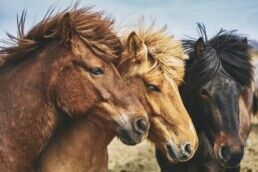
Yes, indeed, Icelandic horses rival Atlantic Puffins, Whales and even Arctic Foxes for the coveted prize of this island’s most iconic animal. Where horses win out is their long-standing relationship with people throughout history. It is a working bond that remains to this day, one which pays homage to this animals’ nickname ‘a most useful servant’.
Given the distances they have travelled with us, the burdens they have carried, and the nourishment they have provided, it’s hard to deny these animals rightfully deserve the esteem we praise upon them. With that said, let’s learn more about these fascinating animals and their critical and historic role in Iceland’s culture and environment.
What are the traits of Icelandic Horses?
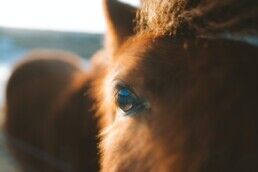
When most people think of Icelandic horses, they remember them to be of more diminutive stature. Generally, Icelandic horses grow to around the size of ponies, though they boast far more robust, more muscular bodies.
Resilient to diseases in their native Iceland, this particular breed is known for its longevity, a trait that has led to solid bonding between animal and man ever since the settlers first brought horses over from Norway in the 10th century.
Icelandic horses can come in over 100 colour varieties, each of which has its corresponding Icelandic word. Four colours are found more commonly than others; chestnut, black, brown and white.
According to some equestrians, prospective riders can assess a horse’s personality through its colouring alone; brown horses are stable on their feet, white are calm and reliable, while chestnut can have lively dispositions. Curious travellers will have to stop by a stable on their visit to check the veracity of these claims, of course.
PLAN YOUR JOURNEY
Travelling to Iceland?
Check our overnight tours with a driver guide that includes a one night stay in a bubble.*Starting from ISK 74.900 per person
Five unique gaits of the Icelandic horse
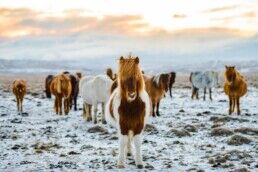
The Icelandic horse differentiates itself from other horse breeds through its natural ability to gait in five ways. For laypeople, a gait is the natural manner of walking for a horse or any animal. Icelandic horses can fluidly perform gaits known as the walk, the trot, the canter, the tölt, and the flying pace.
The walk, the trot and the canter are common to all horses, but the last two make Icelandic horses stand out from the crowd. Both are fast movements, with the flying pace capable of reaching 30 mph. In Iceland, any horse rider who can successfully perform the flying pace is said to have mastered the art of the saddle.
What is the History of Horses in Iceland?
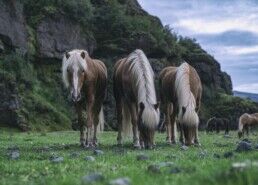
During these formative years, in the earliest days that Norsemen first civilised this dark and inhospitable land, horses were considered symbols of fertility and routinely sacrificed as part of elaborate religious ceremonies and banquets.
Readers of Norse Mythology will likely remember the proud eight-legged steed, Sleipnir, who the legends claim could only be tamed by Odin, the All-father, himself.
Beyond mere mythology, horses were considered prized possessions during Medieval times in Iceland. We know for a scientific fact that clan leaders, known as Godar, were often buried alongside their horses, showing a kinship rarely seen through archaeological evidence.
More cruelly, horses were often pitted against one another in deliberate battles to the death during this period, serving as avatars for opposing clans looking to settle their disputes.
In the centuries that followed the initial settlement of Iceland, a blend of natural selection and selective breeding formed these animals into those we see today. Natural selection came in the form of severe famines that have struck Iceland at various times in its history, as well as the often inhospitable winter weather and even volcanic eruptions.
What are the breeding regulations for Icelandic horses?
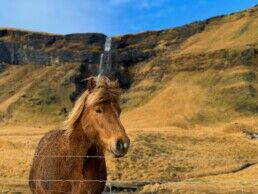
With all this in mind, it is, perhaps, little surprise that the import and export of Icelandic horses is subject to strict regulations; measures imposed to protect the breed’s genetic purity.
Rules are so strict, in fact, that any horse that leaves Iceland is forbidden from returning. In the opposite case, Iceland does not allow any other species of horse into the country. While these rules might seem to fly in the face of biodiversity, it is crucial to ensure that 1000 years of untampered breeding can continue without obstacle.
There are approximately 80,000 or so horses in Iceland currently, just less than a quarter of the total number of people living here. The largest population of Icelandic horses outside of the country is in Germany, where the breed is increasingly popular with riding clubs and breeders.
Can you go Horseback Riding in Iceland?
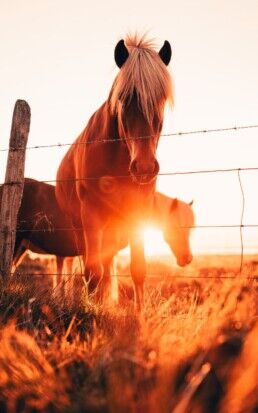
Discovering Iceland’s countryside by horseback is, perhaps, the most authentic and thrilling means of sightseeing visitors can partake in. Equestrian centres and stables across Iceland are well-practised leading beginners and experts alike on tours, and will do their utmost to partner riders with an animal of suitable temperament.
Horseback riding tours can be undertaken regardless of the season. Summer allows for long evenings under the rays of the Midnight Sun, revealing beneath it a landscape of mossy lava rock, sweeping mountain plains and trickling glacial rivers.
If you should stop by in winter, prepare for terrains reminiscent of Narnia; utterly bejewelled, twinkling and calm. That is, of course, if it’s not otherwise shrouded in the dramatic mist and sleet that comes hand-in-hand with the season. Regardless of when you choose to visit for your horseback riding tour, the landscapes of Iceland are sure to delight and inspire awe in all places.
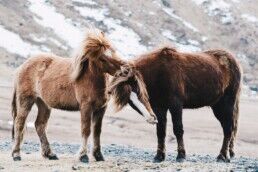
PLAN YOUR JOURNEY
Travelling to Iceland?
Check our overnight tours with a driver guide that includes a one night stay in a bubble.*Starting from ISK 74.900 per person